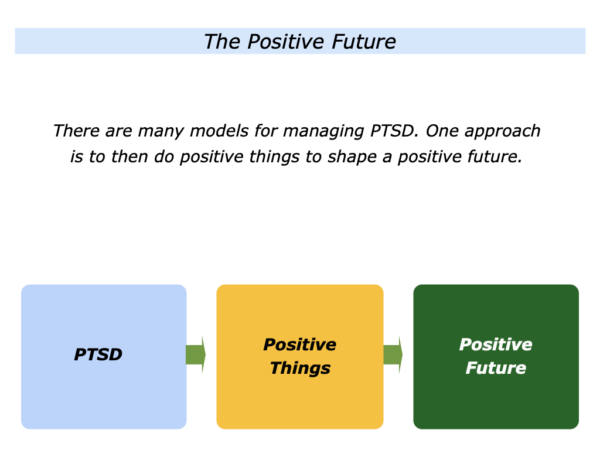
There are many models for managing Post Traumatic Stress Disorder. The following section describes one approach. It then focuses on how a person may do positive things to shape a positive future.
One key point to underline. This piece describes some of the approaches that people have taken. It does not in any way replace professional or medical help. It may therefore be important to seek such advice and help to deal with PTSD.
Managing PTSD
Imagine that a person has experienced a traumatic event. They may have had a serious injury, been the victim of crime, suddenly lost a loved one or had another event that has shattered their life.
They may then experience Post Traumatic Stress Disorder. There are several definitions for this condition. Here is one description.
PTSD is a mental health condition that is triggered by a traumatic event that a person may have experienced or witnessed.
The symptoms may include flashbacks, nightmares, severe anxiety and uncontrollable thoughts about the event.
There are many models for helping a person to manage such emotions. The following section describes one approach.
Babette Roschild – The
Safe Trauma Therapy Approach
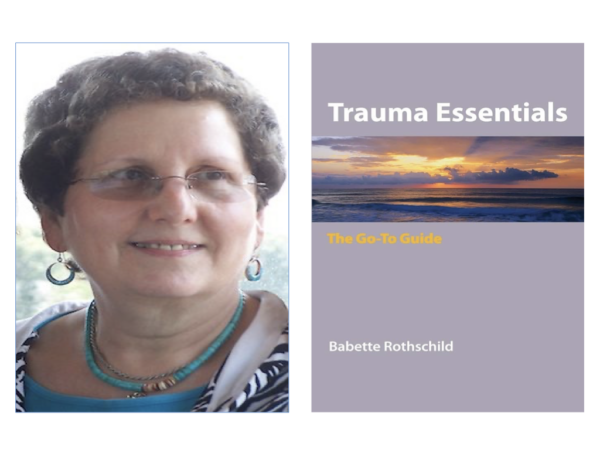
Babette has helped many people to deal with traumas. Her work combines kindness, wisdom and practical tools. She says:
“The first goal of trauma recovery should and must be to improve your quality of life on a daily basis.”
She creates a safe environment in which a person feels at ease. She then, if appropriate, provides practical tools that they can use:
To manage flashbacks and traumatic feelings;
To build on their inner strengths and successful patterns for dealing with challenges;
To add further skills they can use to improve the quality of their lives.
Babette is considered an expert in her field but she also believes that people often resolve many issues without requiring professional help. She explains this in the following way.
“The vast majority of humans who experience traumatic events resolve them on their own, relying on internal resources, the family, the community, the environment, spiritual beliefs and so forth.”
When people do seek Babette’s professional help, however, she helps them to add to their repertoires for shaping their futures. Writing in her book Trauma Essentials, she describes ten principles she believes are essential for safe trauma therapy.
Below is a summary of these principles. The direct quotes from Babette are written in italics. The other text is mine.
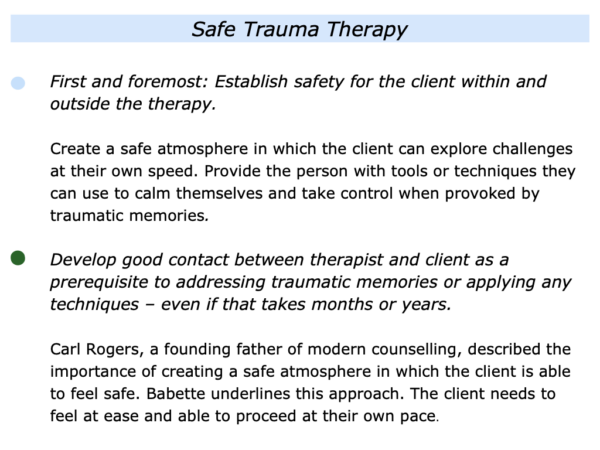
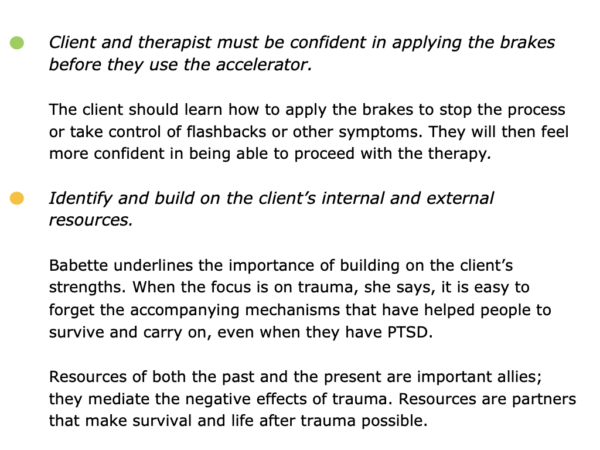
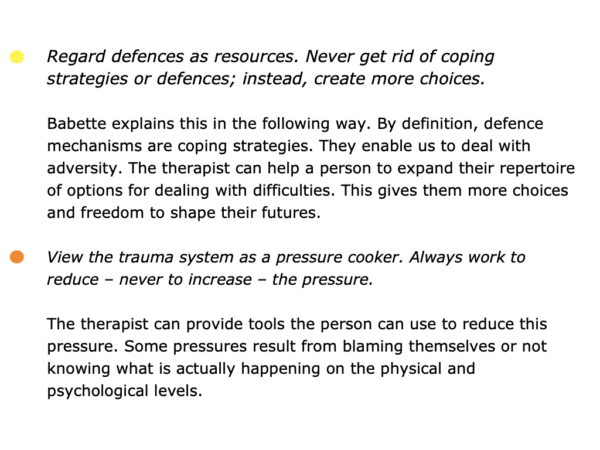
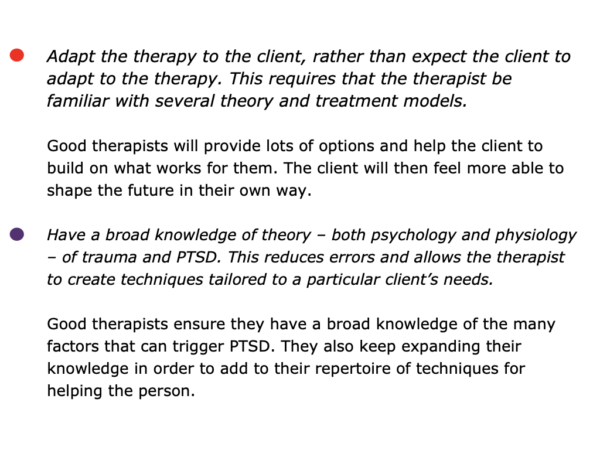
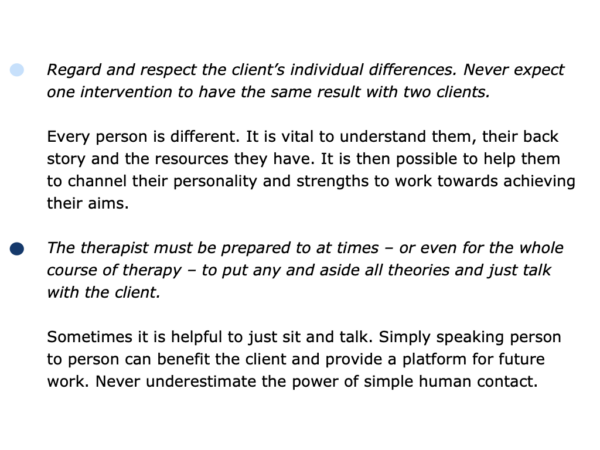
Let’s conclude with a somewhat controversial view. Babette says there is a prevailing belief in the trauma recovery world that all traumas need to be resolved by the memories being processed.
This may be a useful approach for some people, she says, but it is not always the case. At lectures Babette asks people:
“How many of you have had a trauma in your history that you have not worked on but nonetheless function fairly well in spite of?”
She says that around two thirds of the people raise their hands. They have shown it is possible to progress their recovery without being obliged to relieve painful memories. They can be helped to move forward in other ways.
Babette continues to do superb work with safe trauma therapy. She provides many practical tools that people can use to enrich the quality of their lives.
Imagine that a person has developed ways of managing their PTSD. They may then move on to the next stage for shaping their future.
Doing Positive Things
People who experience traumas can find themselves going into negative cycles. They may need to relearn how to do things that give them positive energy. These can help them to heal and re-energise their system.
Imagine that a person who has had a trauma wants to take this step. One approach is for them to follow some of the guidelines described by Barbara Fredrickson. Let’s explore this theme.
Barbara Fredrickson – Positivity
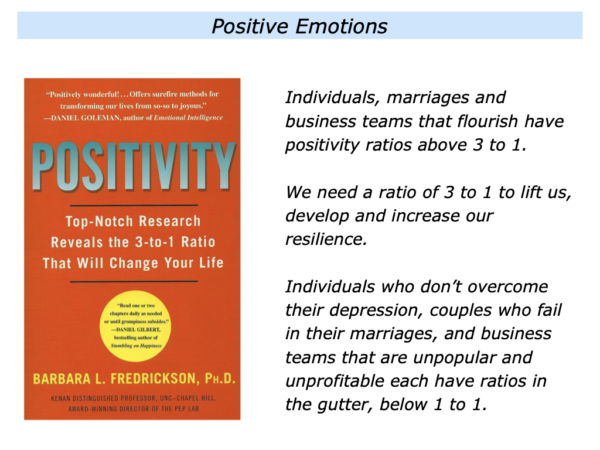
Barbara did pioneering work that demonstrated how positive emotions can improve our lives. Twenty years of research into emotions culminated in her book Positivity.
The book was based on solid research but it also captured the imagination. Why? Interviewers and readers focused on a key theme that provided a signpost to the future.
People who have positive emotions in a ratio of 3:1 in relation to negative emotions are more likely to flourish.
Barbara saw this pattern repeated in marriages and teams that thrived. People who experienced more negativity were more likely to have difficulties.
She explains that positivity is more than simply being happy. It certainly isn’t putting on a smiling face to grin and bear things. Positivity is based on being true to ourselves.
It embodies gratitude, love, playfulness, curiosity and adventure. These emotions trigger each other and create an upward spiral. They broaden and build, helping us to make breakthroughs and bring new things into being.
Such emotions provide the basis for creativity, problem solving and even evolution. They enable us to open our hearts and minds. Negativity, on the other hand, closes down our ability to think, create and grow. Barbara explains this in the following way.
Positivity consists of the whole range of positive emotions – from appreciation to love, from amusement to joy, from hope to gratitude, and then some.
The term is purposely broad. It includes the positive meanings and optimistic attitudes that trigger positive emotions as well as the open minds, tender hearts, relaxed limbs, and soft faces they usher in.
It even includes the long-term impact that positive emotions have on your character, relationships, communities and environments.
Barbara discovered that people could improve their wellbeing by improving their positivity ratio. She likened this to changing their diet to eat healthier food. They needed maintain this positive diet, however, rather than keep exposing themselves to negativity.
She listed ten forms of positivity that can nourish the soul. People can do both simple and big things that generate the following emotions in themselves and other people.
Gratitude … Joy … Love … Hope … Inspiration … Amusement … Awe … Interest … Pride … Serenity.
People who maintain these habits will create an upward spiral that takes them beyond the tipping point. They are then more likely to increase the wellbeing of both themselves and other people.
Imagine that a person who has experienced trauma takes this approach. They can do things that give them positive energy and increase their positivity ratio. This can the help to increase their personal wellbeing.
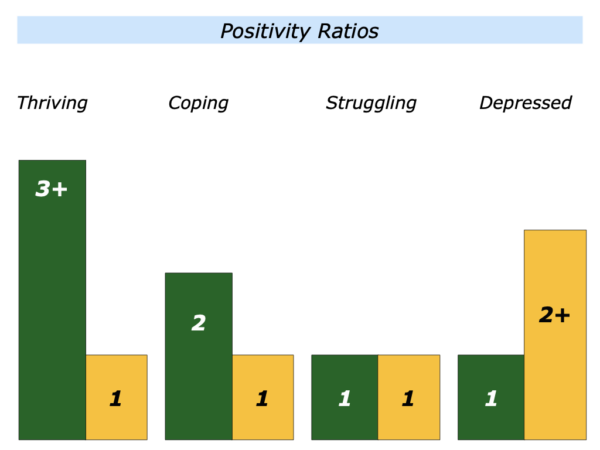
Shaping A Positive Future
People need hope so it can be important for them to focus on how they can shape a positive future. One approach is for them to do something each day towards achieving their life goals. Here is an exercise on this theme.
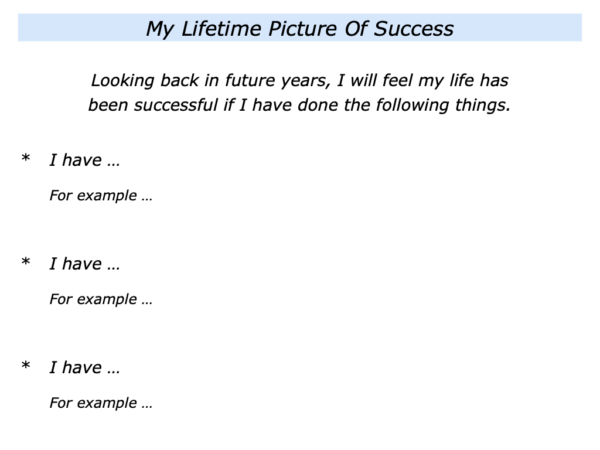
Everybody has different pictures of success. Looking back on their life in future years, what for them will mean they have had a successful life?
Many people say they want to have built a happy family and had a successful career. Some also recognise that success can mean having a sense of peace.
It means looking back and feeling they have done their best during their time on the planet. People often cover three themes when doing this exercise.
Positive Relationships
People may describe how they want to be remembered as a parent, partner or friend. A person may say, for example:
I want my partner and I to have given our children the opportunity to enjoy a happy childhood. For example, I want them to say things like:
“Our parents were always there for us. They encouraged us, helped us to develop our talents and learn how to make good decisions.”
Positive Experiences
People often focus on how they want to enjoy life, pursue experiences and have no regrets. A person may say something like:
I want to have lived life fully. For example, I want to have visited many countries … To have completed the book I promised myself I would write … To have made full use of my talents.
Positive Contribution
People often talk about wanting to make a positive contribution to the world. Sometimes this can lead to having a sense of peace.
This may involve them following their vocation or doing something that improves life for other people. So a person may write something like:
I want to have used my strengths to have done positive work that has helped other people. For example, I want: To have … To have … To have …
Different people clarify their life goals in different ways. Whatever approach they take, clarifying these goals can act as a long-term compass.
A person can bear these aims in mind when making key decisions. When given the opportunity to take a new job, for example, they can ask themselves:
Will taking this step help me to achieve my longer-term picture of success?
Let’s return to the person who has experienced a trauma. If appropriate, they may want to clarify their life goals. They may then find it useful to do one thing early each day towards achieving their aims.
Some people find this provides a sense of meaning to the day. They also feel more in charge and are doing something towards achieving their long-term picture of success.
Every person is different so different people choose different ways to manage and move forwards from PTSD. Some aim to do positive things and work towards shaping a positive future.
Let’s return to your own life and work. Whilst you may not have PTSD, can you think of a situation where you may want to follow elements of this approach? How can you do this in your own way?
If you wish, try tackling the exercise on this theme. This invites you to complete the following sentences.
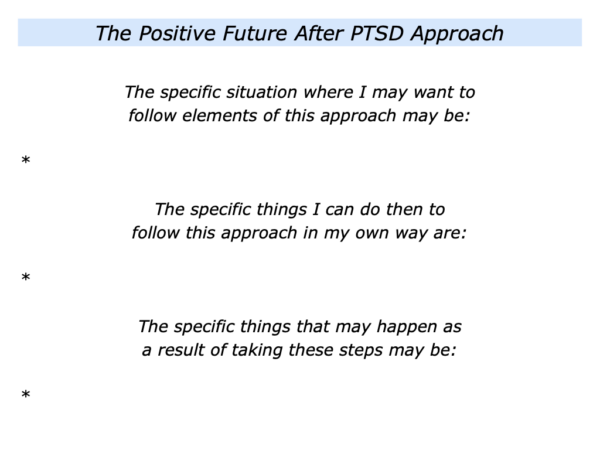


Leave a Reply